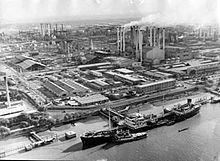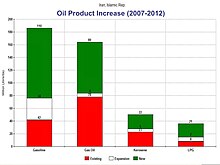
National Iranian Oil Refining and Distribution Company (NIORDC) is part of the Ministry of Petroleum of Iran. NIORDC was established on 8 March 1991 and undertook to perform all operations relating to refining and distribution of oil products.

National Iranian Oil Refining and Distribution Company (NIORDC) is part of the Ministry of Petroleum of Iran. NIORDC was established on 8 March 1991 and undertook to perform all operations relating to refining and distribution of oil products.
|
See also: National Iranian Petrochemical Company |


As of 2010, NIORDC had 19 subsidiaries and affiliated companies, including 9 oil existing refineries.[1] Between 2007 and 2012, oil refining capacity for crude oil and gas condensate would increase from 1,600,000 barrels per day (250,000 m3/d) to 3,300,000 barrels per day (520,000 m3/d).[2] By 2009, Iran had a total refining capacity of 1,860,000 barrels per day (296,000 m3/d).[3]
| Refinery | Installed Capacity (bbl/d) |
|---|---|
| Abadan | 350,000 |
| Isfahan | 280,000 |
| Arak (Imam-Khomeini) | 250,000 |
| Bandar Abbas | 230,000 |
| Tehran (Shahid Tondgouyan) | 220,000 (Euro 5 compliant by 2012)[citation needed] |
| Arvand Oil Refinery | 120,000 |
| Lavan Island | 63,000 (Since 2012) |
| Tabriz | 100 |
| Kermanshah | 40 |
| Shiraz | 30 |
| Total: | 1.45 Mbbl/d (231,000 m3/d). |
| Oil Products | KBPD (thousand barrel per day) | Percent |
|---|---|---|
| Gasoline | 283 | 17% |
| Gas oil | 511 | 32% |
| Kerosene (Jet fuel) | 136 | 8% |
| Fuel oil | 457 | 29% |
| LPG | 50 | 3% |
| Others | 184 | 11% |
Other facilities:
|
See also: 2007 Gas Rationing Plan in Iran, Smuggling in Iran, and Sanctions against Iran |
Major gasoline suppliers to Iran historically have been India, Turkmenistan, Azerbaijan, the Netherlands, France, Singapore, and the United Arab Emirates.[6][7] The Financial Times reported that Vitol, Glencore, Trafigura and other (western) companies had since stopped supplying petrol to Iran because of international sanctions.[8] In 2006, Vitol, a MNC based in Switzerland, supplied Iran with 60% of its total gasoline cargo imports.[6]

| 2008 | 2009 |
|---|---|
| BP (UK) | CNPC (China) |
| ENOC (UAE) | Glencore (Switzerland) |
| Glencore (Switzerland) | IPG (Kuwait) |
| IPG (Kuwait) | Litasco (Russia) |
| MEP (UAE) | Petronas (Malaysia) |
| Reliance Industries (India) | Reliance Industries (India) |
| Shell (Netherlands) | Shell (Netherlands) |
| SPC (Singapore) | Total (France) |
| Total (France) | Trafigura (Switzerland) |
| Trafigura (Switzerland) | Vitol (Switzerland) |
| Vitol (Switzerland) | Zhenhua Oil (China) |
|
See also: List of oil refineries § Iran, and Iranian Economic Reform Plan |
While the country remains dependent on small gasoline and diesel imports, net gasoline imports in 2013 averaged only 33 000 bpd. This compares to refined product imports of 182 000 bpd in 2009, of which two thirds was gasoline (approximately 132 000 bpd).[17]
| Refinery | Location | Refining capacity[18] | Estimated costs [19] | Estimated completion date[19] |
|---|---|---|---|---|
| Khuzestan refinery (privately owned) | Arvand Free Zone, near Abadan | 180,000 barrels per day (29,000 m3/d). The refinery will refine the heavy crude oil produced in Azadegan and Yadavaran oil fields. It will also produce 10 million litres (2,600,000 US gallons; 2,200,000 imperial gallons) of super gasoline complying with Euro IV standard, 12.6 million litres (3,300,000 US gal; 2,800,000 imp gal) of diesel oil, 3 million litres (790,000 US gal; 660,000 imp gal) of jet fuel, 5 million litres (1,300,000 US gal; 1,100,000 imp gal) of liquefied gas, and 440 tonnes (430 long tons; 490 short tons) of sulfur. | 2.9 billion euros | 2012 |
| The Persian Gulf Star refinery | Assalouyeh | 360,000 of gas condensates per day and to produce gasoline, jet fuel, and other valuable products. | 2.5 billion euros | 2010 |
| Shahriar refinery | Tabriz | 150,000 barrels per day (24,000 m3/d); gasoline production: 70,000 barrels per day (11,000 m3/d) | 1.2 billion euros | 2012 |
| Anahita refinery | Kermanshah Province | 150,000 barrels per day (24,000 m3/d) | 1.3 billion euros | 2012 |
| Hormoz refinery | Bandar Abbas | 300,000 barrels (48,000 m3) of heavy and extra heavy crude oil | $4.3 billion | 2012 |
| Caspian refinery | Gorgan, Golestan Province | 300,000 barrels (48,000 m3) of crude oil; 20 million litres (5,300,000 US gal; 4,400,000 imp gal) of gasoline, 11 million litres (2,900,000 US gal; 2,400,000 imp gal) of gas oil from Caspian Sea countries with exports to Turkey, Afghanistan and Pakistan | $4 billion | 2013 |
| Pars refinery | Shiraz | 120,000 barrels per day (19,000 m3/d) | 800 million euros | 2012 |
| Refinery | Location | Refining capacity | Estimated costs | Completion date |
|---|---|---|---|---|
| Yasouj refinery | Yasouj | 150,000 barrels per day (24,000 m3/d). The refinery will produce petrol, gasoil, kerosene, furnace oil, liquefied gas, asphalt, and sulfur.[21] | $2.2 billion | 2014 |
Planned in 2011, Qeshm refinery (capable of processing heavy crude oil) will have an output capacity of 30,000 barrels a day of light oil products and will become operational by 2014.[22]
The NIORDC subsidiaries are as follows: